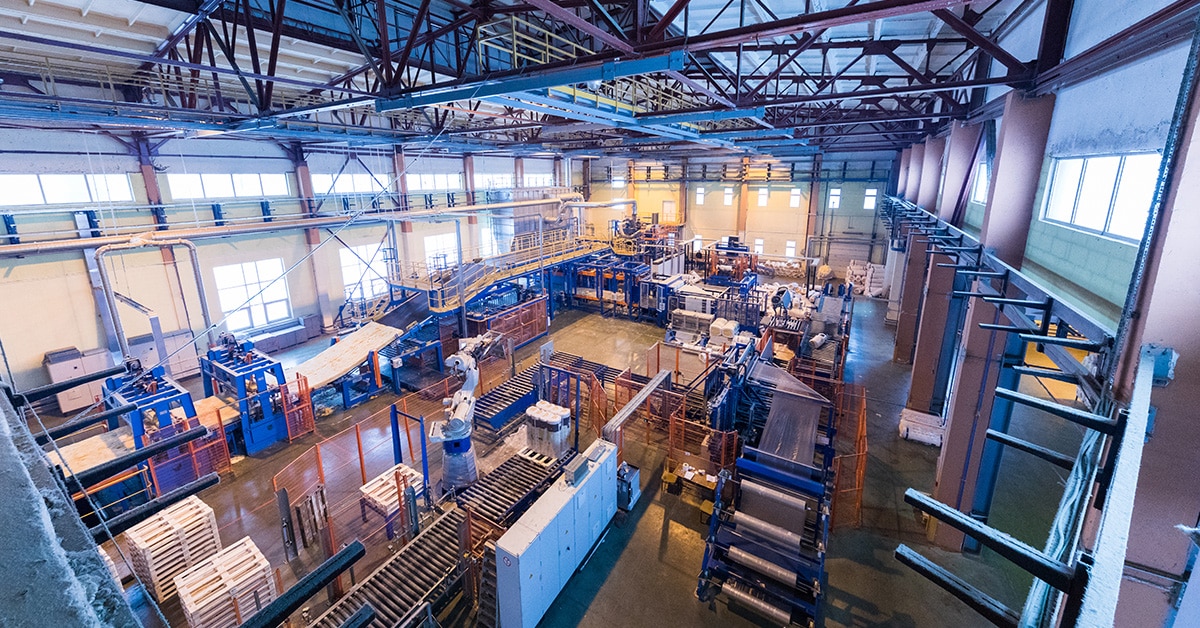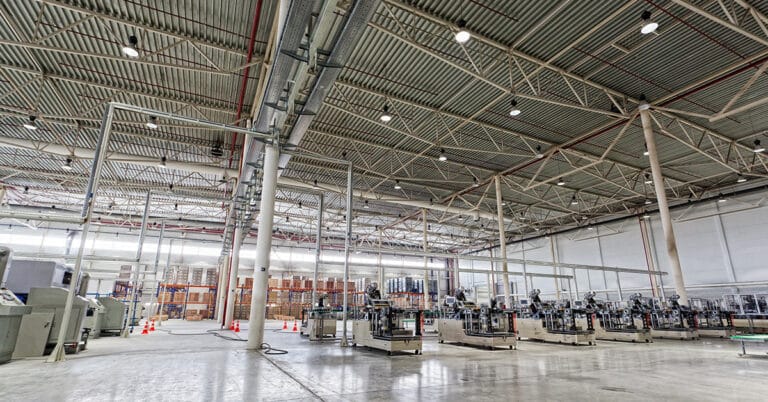Industrialization enhances production speed, while globalization provides scale. In combination, these two concepts shaped today’s market landscape and continue to influence everything from manufacturing practices and supply chain strategies to national and international policies.
Consider logistics, the movement of components and products from one place to another. According to recent survey data, U.S. businesses now spend $2.3 trillion on logistics each year, which amounts to 8.7% of the national GDP. Both industrialization and globalization fuel these costs; companies are now capable of producing massive amounts of high-quality goods at speed and shipping them anywhere in the world.
Here’s a look at industrialization, globalization and their impact on modern manufacturing.
Understanding industrialization
Industrialization is the development of manufacturing capacity, automation and infrastructure to improve the performance and consistency of production lines.
Today, manufacturers are navigating the impact of Industry 4.0, or the Fourth Industrial Revolution. But how did we get here?
Industrialization took shape in the late 18th century, marking the first major shift in manufacturing. New materials like steel and innovations such as the spinning jenny and power loom transformed production—making it faster, more consistent and less dependent on manual labor.
By the late 19th century, automation and mass production reshaped manufacturing. Shops evolved into factories with production lines that assembled products in discrete steps, rather than from start to finish. In addition, skilled technicians for industrial maintenance became a necessity to keep equipment up and running.
In the mid-20th century, automation gave way to digitization and marked the start of the third industrial revolution. Hallmarks of the third industrial revolution include communication and information—what began with computers and servers evolved into cloud connections and mobile devices. This also prompted the evolution of industrial maintenance to include real-time data monitoring and decision-making.
These technologies set the stage for Industry 4.0, which uses robotics, advanced automation, artificial intelligence (AI) and IIoT devices to create smart factories capable of optimizing production processes and proactively detecting potential problems. Industry 4.0 focuses on productivity gains, operating efficiency, machine uptime and product quality.
Key impacts of industrialization on operations include:
- Improved factory throughput and overall equipment effectiveness (OEE) improvements
- Greater reliance on skilled technical labor
- The need for data-driven asset and maintenance strategies
Understanding globalization
Globalization is the expansion of international trade and global supply networks. Industrialization made globalization possible. Improvements in communications, logistics and product consistency laid the groundwork for global networks that enabled multisource supply chains and worldwide delivery.
For manufacturers, globalization offers benefits such as more resilient supply chains, reduced manufacturing costs tied to outsourcing and offshoring and broader access to materials and labor across international markets.
Globalization also leads to significant impacts on operations, including:
- Increased supply chain complexity and risk exposure
- Cost pressures that drive margin-focused production
- Variability in compliance regulations across regions
Key differences: Industrialization vs. globalization
Both industrialization and globalization play key roles in modern manufacturing, but their objectives differ. While industrialization prioritizes expanding production, globalization focuses on expanding markets.
The right mix of globalization and industrialization depends on your operational priorities, labor mix and market focus.
Factor | Industrialization | Globalization |
Primary focus | Production expansion | Market expansion |
Operational drivers | Automation and efficiency | Cost optimization |
Risks | Capability gaps, CapEX | Supply chain disruptions |
Labor needs | Skilled technical workforce | Distributed workforce |
Uptime impact | Increased control | Increased vulnerability |
How industrialization & globalization work together
Industrialization and globalization are interconnected.
For example, global supply chains are only made possible by industrialized capacity. Components must be produced quickly and consistently for companies to receive, manufacture and ship finished products to customers.
Industrialized factories, meanwhile, require global market access and resources. Many manufacturing processes now depend on rare earth metals or chemical elements that cannot be locally sourced, making global cooperation essential.
Global manufacturing strategies often balance precision, scale and cost efficiency. For example, a German manufacturer focused on bespoke digital devices may source components from large Asian electronics suppliers to maintain consistent performance. Similarly, a U.S. automaker might automate parts production locally with advanced machinery while near-shoring assembly to Mexico to optimize labor costs.
In both cases, cooperation is critical for success. The result is a multiregional, interdependent manufacturing ecosystem.
Global risks & reindustrialization trends
Globalization offers a way to reduce costs and improve productivity by purchasing components directly from the source and making the best use of growing labor markets. But going global also comes with risk.
Disruptions top the list. For example, recent economic and geopolitical tensions have led to unpredictable market shifts that can leave companies struggling to keep parts in stock. The 2020 pandemic, meanwhile, made it abundantly clear that single-source global supply chains left companies vulnerable to necessary restrictive terms on importing and exporting. This also underscored the importance of a resilient MRO supply chain to keep materials and parts moving even during large-scale disruptions.
Rising logistics and labor costs are eroding the advantages of international outsourcing. The result? Smaller margins paired with a greater risk of disruption are driving three manufacturing trends.
1. Reshoring. Reshoring in manufacturing brings processes and production lines back to local factories and shops. With supply chain disruptions often more costly over time than higher local labor costs, reshoring provides increased process security without breaking the bank.
2. Nearshoring. Another trend is nearshoring. This sees production processes moving closer to home, such as to nearby countries that have historically strong ties with your nation. Nearshoring can help save on labor and people costs while still providing shorter and more reliable supply lines.
3. Supply chain diversification. Supply chain diversification eliminates reliance on a single supplier, in turn reducing the risk of disruptions. Consider a company that requires rare earth metals for key manufacturing processes. Using a single-supplier model, even a small disruption in component availability can lead to production slowdowns or stoppages. By spreading supply needs across two, three or more vendors, businesses can create a backstop against unexpected issues.
For manufacturers, uptime is king. Shorter supply lines mean faster component access and reduced downtime risk. While globalization will always have a place in manufacturing, it’s now part of a larger, interconnected framework that combines local and global sources.
The role of technology as the bridge
Technology acts as a bridge between local speed and global scale. Common use cases include:
- Smart automation: Automated production line equipment and intelligent software tools can enable localized production at a global scale by ensuring that processes are standardized, accurate and repeatable.
- Unified data strategies: Creating unified data strategies makes it easier to collaborate with facilities and factories worldwide since all equipment and processes use the same data format and storage frameworks. These strategies underpin the large trend toward digital transformation in manufacturing.
- Predictive maintenance: Predictive maintenance helps protect production in distributed networks. For example, if predictive tools indicate the need for in-depth maintenance on a critical piece of local machinery that will take it out of service for two weeks, companies can plan to shift additional production loads to other global lines.
- Digital platforms: The use of digital platforms such as manufacturing execution systems (MES) and computerized maintenance management systems (CMMS), along with machine-to-machine communications protocols such as OPC UA, enables global-to-local visibility for increased control.
Maintenance and workforce implications
Both industrialization and globalization impact workforce requirements. For example, industrialization requires skilled technicians to ensure efficient equipment operations, along with modern training programs to keep front-line staff and maintenance experts up-to-date. In addition, local production lines benefit from AI-assisted maintenance systems that can proactively detect potential issues and alert staff to needed repairs. Streamlining MRO procurement processes ensures that critical components are available when and where they’re needed, minimizing downtime across facilities.
Globalization, meanwhile, needs standardized work practices to ensure that products and components are consistent across locations. In addition, companies need scalable asset management frameworks that allow them to ramp up production volumes in response to demand.
Manufacturers must also recognize the impact of growing labor shortages, both at home and abroad. These changing labor conditions highlight the importance of OEM partnerships to ensure component quality, the need for remote diagnostic tools that can detect issues anytime, anywhere, and the increasing benefits of contract maintenance companies to perform proactive, scheduled and emergency maintenance.
Choosing the right strategy for your business
Globalization or industrialization? For manufacturers to stay competitive, it’s both. The key is finding balance. Depending on current demand, existing infrastructure and available labor, businesses may see bigger benefits going offshore or greater advantages staying closer to home.
To find your balance, start with a data-driven assessment of:
- Supplier footprint stability: How stable are your current suppliers? How many disruptions have they had over the last year? Two? Five? Of these disruptions, what was the primary cause? If a supplier faced five week-long disruptions and four were tied to geopolitical issues, it’s a signal to rethink your strategy. Exploring reshore and nearshore options can help strengthen reliability and reduce risk.
- Asset reliability maturity: How reliable are your assets, and how robust is your program for measuring reliability? Until you have a solid program in place, it’s worth staying local. The farther the equipment gets from your network, the more difficult management becomes.
- Lead time risks: What is the impact of changing lead times? For companies that operate with additional stock on hand, delays of one to two weeks may be minimally disruptive. For those that prefer a just-in-time inventory model, meanwhile, delays of even one or two days may be disastrous.
- Regulatory compliance constraints: Compliance varies across nations and markets. For example, suppliers operating in one country must obey local compliance and labor laws. Any components you receive and use from these suppliers, meanwhile, must comply with local regulations around manufacturing quality, composition and application. Manufacturers subject to strict regulatory controls, such as those that produce food or beverages, often benefit by keeping production closer to home.
Not sure which way the scales should tip? Businesses are always better served by prioritizing uptime and operational resilience over lower-cost geography. Industrialization accelerates production capability, globalization expands markets, and both are necessary for long-term success. Support your Industry 4.0 initiatives and enhance your global impact with ATS. Let’s talk.
References
PR Newswire. (2024, June 18). The 2024 CSCMP State of Logistics Report shows how logisticians are adapting to permanent volatility in their supply chains. https://www.prnewswire.com/news-releases/the-2024-cscmp-state-of-logistics-report-shows-how-logisticians-are-adapting-to-permanent-volatility-in-their-supply-chains-302175054.html
Magill, K. (2024, April 16). Manufacturing could be short 1.9M workers if the talent gap isn’t fixed. Supply Chain Dive. https://www.supplychaindive.com/news/manufacturing-labor-shortage-2033-deloitte-mi-report-2024/713326/






